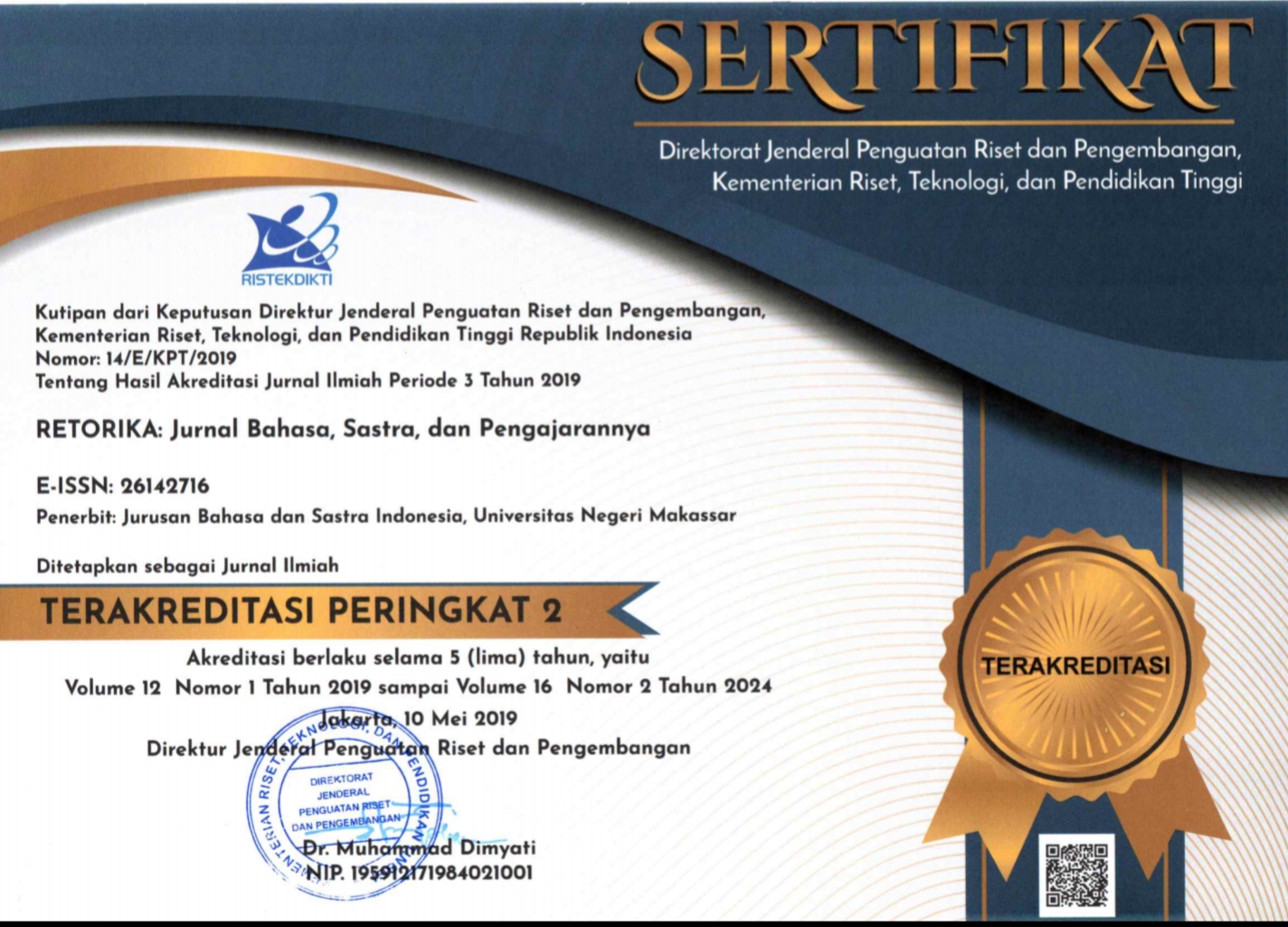MEKANISME EUFEMISME DAN SENSORISASI: KEKERASAN SIMBOLIK DALAM TUTURAN DOSEN
(1)
(2)
(3)
(*) Corresponding Author
DOI: https://doi.org/10.26858/retorika.v12i2.9101
Abstract
Abstract: Symbolic Violence Representation in the Mechanism of Euphemism and Sensori-zation of Lecturer Speech. This study aims to describe the representation of symbolic violence in the mechanism of euphemism and censorship of lecturers' speeches to students in the class. This study uses a qualitative approach with a type of case study research. Data in the form of sentences in lecturer speech to students. Data collection techniques used are observation, recording, and recording. Bourdieu's social class theory which was constructed in the mechanism of euphemism and censorship became the basis for studying this research data. Symbolic violence is represented in the mechanism of euphemism and the censorship mechanism. The results of the study show that symbolic violence through lecturer speech inspired by institutional authority shapes the behaviors, thoughts, and beliefs that can be accepted in certain social spaces. This is done on the basis of "to educate" students to behave and act better.
Keywords
Full Text:
PDFReferences
Amirulloh, S. 2018. Understanding of Symbolic Vio-lence in Realizing The Conducive Educational Ecosystem (Study on MAN Kota Batu). Jurnal Partisipatoris, 1 (1): 36–44.
Bhambra, G. K., and Shilliam, R. 2009. Silent and Human Right, in Silencing Human Rights: Critical Engagements with a Contested Pro-ject. Basingstoke: Palgrave Mac Millan, 1-19.
Bernstein, B. 2000. Pedagogy, Symbolic Control and Identity: Theory, Research, Critique, revised edn. Lanham, MD: Rowman & Littlefield.
Bourdieu, P. 1991. Language and Symbolic Power (J. B. Thompson, Ed., G. Ramond and M. Adamson, Trans.). Cambridge: Harvard University Press and Polity Press.
Daradjat, Z., et al. 2002. Ilmu Pendidikan Islam. Cet. II. Jakarta: Bulan Bintang.
Foucault, M. 1995. Discipline and Punish: The Birth of the Prison, trans. A. Sheridan, 2nd edn. New York: Vintage Books.
Goldstein, Rebecca A. 2005. “Symbolic and Institu-tional Violence and Critical Educational Spa-ces: In the Name of Education. Journal of Peace Education, 2:33–52.
Haryatmoko. 2003. Menyingkap Kepalsuan Budaya Penguasa. Jurnal Basis, 11: 5–23.
Jalaluddin. 2001. Teologi Pendidikan. Jakarta: PT Raja Grafindo Persada.
Jufri. 2008. Analisis Wacana Kritis. Makasar: Badan Penerbit Universitas Negeri Makasar.
Martono, N. 2012. Kekerasan Simbolik di Sekolah: Sebuah Ide Sosiologi Pendidikan Pierre Bourdie. Depok: PT Raja Grafindo Persada.
Miles, M.B, Huberman, A.M, dan Saldana, J. 2014. Qualitative Data Analysis, A Methods Soucebook, Edition 3. USA: Sage Publications
Pace, W. R. & Don F. F. 2006. Komunikasi Organi-sasi. Bandung: PT. Remaja Rosda Karya.
Panikkar, R. 1999. Four Attitude. In Garry E. Kessler (Ed.). Philosophy of Religion: Toward a Global Perspective. Canada: Wardsworth Pub-lishing Company.
Rusdiarti, S. R. 2003. “Bahasa, Pertarungan Simbo-lik, dan Kekuasaan.” Jurnal Basis, 11: 12–21.
Schubert, J. D. 1995 From a politics of transgression toward a theory of reflexivity. American Beha-vioural Scientist, 38(7), 1003–1017.
Scott, B. C. 2012. Caring Teachers and Symbolic Violence: Engaging the Productive Struggle in Practice and. Research. Educational Stu-dies, 48:530—549. doi: 10.1080/00131946. 2012.733279.
Slavin, R. E. 2009. Cooperative Learning (Teori, Riset, dan Praktik). Bandung: Nusa Media.
Suharno, S & Gendri, H. 2013. Model Peace-Building Teaching and Learning: Sebuah Intervensi Pencegahan Kekerasan melalui Pendidikan Formal. (Online), (http://eprints. uny.ac.id/23718/pdf), diakses pada 27 Juli 2019).
Thapar-Björkert, S. Samelius, Sanghera, L., Gurcha-then, S. 2016. Exploring Symbolic Violence in The Everyday: Misrecognition, Condescen-sion, Consent and Complicity. Feminist Review.. 112 (1):144–162.
Ulfah. 2013a. Kekerasan Simbolik dalam Wacana Pembelajaran. Jurnal Penelitian Pendidikan INSANI, 14 (1):51–58.
Ulfah. 2013b. Eufemisme sebagai Mekanisme Kekerasan Simbolik dalam Pembelajaran di Sekolah. Jurnal Kreatif Untad. 16 (3):80–86.
Zuhra, W. U. N. 2019. Dosen Predator yang Masih Berkeliaran di UIN Malang. (Online), (tirto.id), diakses 20 Mei 2019.
Article Metrics
Abstract view : 1270 times | PDF view : 226 timesRefbacks
- There are currently no refbacks.
Copyright (c) 2019 aswadi abuafkar

This work is licensed under a Creative Commons Attribution-NonCommercial 4.0 International License.
Published by:
Department of Indonesian Language, Faculty of Languages and Literature, Universitas Negeri Makassar in cooperate with Asosiasi Dosen Bahasa dan Sastra Indonesia (ADOBSI) and Ikatan Program Studi Pendidikan Bahasa dan Sastra Indonesia (IKAPROBSI).
Address: Department of Indonesian Language Office, DG Building Second Floor, UNM Parangtambung, Daeng Tata Raya Street, Makassar, South Sulawesi, Indonesia
 Email: [email protected]
Email: [email protected]

RETORIKA: Jurnal Bahasa, Sastra,dan Pengajarannya is licensed under a Creative Commons Attribution-NonCommercial 4.0 International License.
















